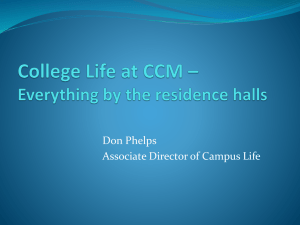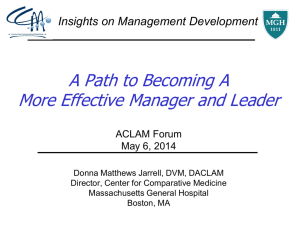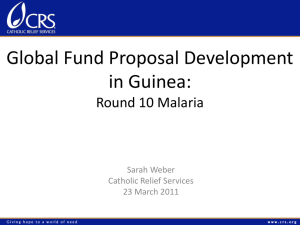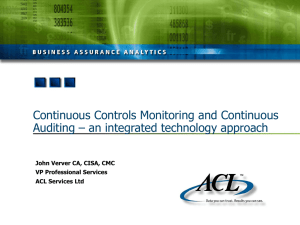MOBILISING FOR CHANGE OUR APPROACHES TO CHANGE PART ONE
advertisement
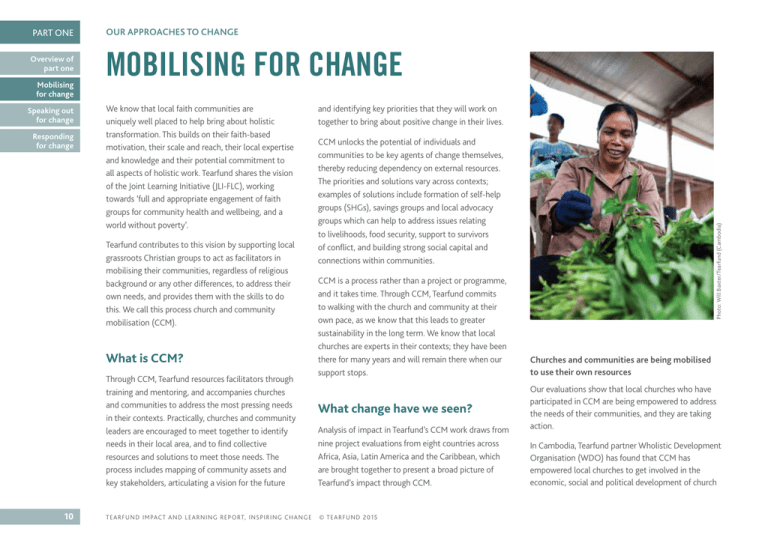
PART ONE OUR APPROACHES TO CHANGE Overview of part one MOBILISING FOR CHANGE Speaking out for change Responding for change We know that local faith communities are uniquely well placed to help bring about holistic transformation. This builds on their faith-based motivation, their scale and reach, their local expertise and knowledge and their potential commitment to all aspects of holistic work. Tearfund shares the vision of the Joint Learning Initiative (JLI-FLC), working towards ‘full and appropriate engagement of faith groups for community health and wellbeing, and a world without poverty’. Tearfund contributes to this vision by supporting local grassroots Christian groups to act as facilitators in mobilising their communities, regardless of religious background or any other differences, to address their own needs, and provides them with the skills to do this. We call this process church and community mobilisation (CCM). What is CCM? Through CCM, Tearfund resources facilitators through training and mentoring, and accompanies churches and communities to address the most pressing needs in their contexts. Practically, churches and community leaders are encouraged to meet together to identify needs in their local area, and to find collective resources and solutions to meet those needs. The process includes mapping of community assets and key stakeholders, articulating a vision for the future 10 T E A RF U ND IMPACT AND LEARN ING REPORT, I NSPI R ING CHA NGE and identifying key priorities that they will work on together to bring about positive change in their lives. CCM unlocks the potential of individuals and communities to be key agents of change themselves, thereby reducing dependency on external resources. The priorities and solutions vary across contexts; examples of solutions include formation of self-help groups (SHGs), savings groups and local advocacy groups which can help to address issues relating to livelihoods, food security, support to survivors of conflict, and building strong social capital and connections within communities. CCM is a process rather than a project or programme, and it takes time. Through CCM, Tearfund commits to walking with the church and community at their own pace, as we know that this leads to greater sustainability in the long term. We know that local churches are experts in their contexts; they have been there for many years and will remain there when our support stops. What change have we seen? Analysis of impact in Tearfund’s CCM work draws from nine project evaluations from eight countries across Africa, Asia, Latin America and the Caribbean, which are brought together to present a broad picture of Tearfund’s impact through CCM. © T EA R FUND 20 15 Photo: Will Baxter/Tearfund (Cambodia) Mobilising for change Churches and communities are being mobilised to use their own resources Our evaluations show that local churches who have participated in CCM are being empowered to address the needs of their communities, and they are taking action. In Cambodia, Tearfund partner Wholistic Development Organisation (WDO) has found that CCM has empowered local churches to get involved in the economic, social and political development of church OUR APPROACHES TO CHANGE members and local communities. At the community level, members are assessing their own needs and resources and are planning and implementing small projects for the benefit of their families and communities. The churches and communities engaged with WDO have learnt the value of using local resources to solve their problems and meet their own needs. As a result, there have been significant improvements in the living conditions of the target communities: ■ Food security Many households are benefiting from improved agriculture practices and animal raising, which has helped them to become more food secure. ■ Health Communities are increasingly aware of good health and sanitation practices due in part to the training provided by WDO; 70 per cent of people in the target villages now wash their hands with soap before eating. ■ Participation Community members are coming together with greater awareness of the issues facing them. In A self-help group (SHG) is typically a group of 15 to 20 people who are often from the poorest sectors of the community. External facilitators help each group to develop positive relationships and social connections, discuss common goals, set up a saving scheme and establish rules and bylaws on how they will operate. particular, people have an increased level of knowledge about human trafficking, child abuse and domestic violence. They are now keen to attend training courses or meetings on these issues. From dependency to self-sufficiency As well as practical action, our evaluations show that the CCM process has encouraged a significant shift among both church and community members, away from dependency on external sources and towards self-sufficiency or ‘self-help’. This was expressed as a challenge by a number of evaluations as CCM projects are working against the status quo of traditional topdown development projects where financial resources are given; instead, they encourage a bottom-up approach where communities use their own resources to solve problems corporately. Although the process takes time, once churches and communities see their future in a different way, the results are very positive and sustainable as communities feel a deeper sense of ownership of the initiatives. A great example of this is the growth of self-help groups (SHGs), which have been particularly well established in Ethiopia. A cost benefit analysis (CBA) of this work found that the social impact was most significant: ‘SHG members talk constantly about increased confidence and skills, the ability to relate better to one another, the sense of support they feel from one another, and the strong sense of empowerment and dignity.’ Tearfund has a Church and Development Community of Practice (CoP) which is a valuable platform for sharing knowledge and learning across organisations and internally. The CoP has 247 members from 83 organisations across 45 countries. A member from Cambodia says: ‘The CoP inspires and gives encouragement all the time when I realise that I am not alone in facing challenges and we have opportunity to share and help one another.’ PART ONE Overview of part one Mobilising for change Speaking out for change Responding for change development of collective solutions to problems using local resources. (See the Building resilience section, page 39, for more detail on the financial and other benefits of SHGs in Ethiopia.) CCM as the foundation for further sustainable interventions Evidence shows the benefit of the CCM process in laying the foundation for further interventions because of the change process it initiates within the local community. In Uganda, Tearfund partner Pentecostal Assemblies of God (PAG) began a pilot programme to introduce advocacy into the CCM process. CCM facilitators were trained in advocacy methods, and the results were very positive. (Read more about this example in the Speaking out for change section, page 14.) This success relies on a shift away from dependency on donors and NGOs, and towards the T EA R FUND I M PACT A ND L E AR NI N G R E P O RT, I N SP I R IN G C H AN GE © T E AR FU N D 201 5 11 PART ONE Overview of part one Mobilising for change Speaking out for change Responding for change OUR APPROACHES TO CHANGE Cаe S"# each of the partner organisations had been working. In light of concerns that inadequate sub-samples of people with no engagement in the programme might be returned, a small control sample was also obtained from neighbouring communities. Holistic change through CCM in Tanzania Methodology Nine years ago, Tearfund began a CCM process in Tanzania through local partners. In 2013, a quasiexperimental research project led by external consultants was undertaken in the north-west of the country to explore the impact of the process on the lives of community members. A sample of people was drawn from communities in which the CCM process had started in 2008 or earlier. Eighteen research communities were selected in order to give a diverse mix of communities across the six dioceses in which The methodology was based on making comparisons between people in these communities who had been engaged in the CCM process and those who had not; 757 people were surveyed in total. Comparisons were also made between members of CCM communities who had no awareness of the programme and respondents from the control communities; this was in order to highlight where benefits of the programme may have ‘trickled down’ to all members of the community. A whole range of poverty and wellbeing indicators were used to assess the change that had taken place, including Multi Poverty Index indicators of material assets, education and health. ‘Wellbeing’ considers the individual’s access to more than money, and included indicators of education, health, livelihoods and a range of indicators relating to the individual’s social context (such as personal relationships). ■ ■ ■ Photo: Louise Thomas/Tearfund (Tanzania) ■ 12 T E A RF U ND IMPACT AND LEARN ING REPORT, I NSPI R ING CHA NGE Research findings Analysis of the results has highlighted a number of key areas in which participation in the CCM programme (through activities, membership or attendance at meetings) is clearly linked to positive changes, notably improvements in household dwelling, improved agricultural productivity and community relationships. Some of the results are highlighted here: © T EA R FUND 20 15 The quality of the household dwelling was consistently higher among those who had participated in CCM; 44 per cent of participating households had changed or improved their dwelling (compared with 26 per cent of those who had not participated in CCM), and 23 per cent had improved their source of drinking water (compared with 11 per cent). Households who participated in the programme were more actively engaged in agricultural activities and had increased their agricultural productivity; 81 per cent of CCM households had employed at least one improved agricultural practice, compared with 66 per cent in non-CCM households; and 98 per cent of CCM households were growing more than one type of crop compared with 90 per cent among non-CCM households surveyed. There were more women in employment among those who had participated in CCM. Eighty-two per cent of women from CCM communities had worked in the last 12 months, compared with 63 per cent of those not involved in CCM. This implies that the CCM process has contributed to the empowerment of women. A higher proportion of CCM participants were politically engaged: 22 per cent more people who had participated in CCM had raised an issue with local government and taken part in political meetings when compared with nonparticipants, and 29 per cent more were members of community groups (such as SHGs and savings groups). This was accompanied by a more positive view of local government accountability from OUR APPROACHES TO CHANGE CCM communities, which implies that local government performed better. The higher rates of membership of community groups among the CCM community reflect a greater willingness to engage with and improve community life. Throughout all sets of indicators, there was a consistent trend for perceptions of change to be higher among those who had participated in CCM, implying that the process had clearly made people feel more positive about change. Limitations We recognise that the lack of baseline data presents a significant limitation to the evidence found by this study. We also recognise the marginal differences in some cases between the CCM and non-CCM groups. Despite this, the data does indicate positive change among CCM participants. However, in light of the limitations, Tearfund is committing to invest more resources into research into the impact of CCM in particular in the coming year, and is investing more in improving baseline data across all our projects in order to gain a clearer understanding of our impact and to build our evidence base. K! L"#$ In order for CCM to bring about change, Tearfund recognises that a strong and dedicated facilitator is required ✓ The success of CCM is reliant on the facilitator’s understanding and skills to share the process with the church and community. Therefore, the careful selection, training, constant replication, mentoring and ongoing support of facilitators are critical. The responsibility for this lies with the partner, but Tearfund’s role is to help shape and inform how CCM is implemented. It is Tearfund’s role to ensure that there is adequate understanding and ownership from the partner, including staff time allocated and support structures in place to develop facilitators. CCM works towards behaviour change, making it a slow process which requires perseverance and a long-term strategy ✓ CCM is a process not a programme, requiring perseverance and a long-term strategy. It is about walking with the church and community to help them realise their vision and equip them to achieve it. CCM moves away from the traditional ‘handout’ development culture and Overview of part one Mobilising for change it can take time to see changes in behaviour, attitudes and practices. It is worth the initial and ongoing investment in leadership envisioning as once CCM is understood it leads to a genuinely sustainable process owned by the church that has the potential to be multiplied without Tearfund and our partners. ✓ PART ONE Speaking out for change Responding for change Targeting the most vulnerable people in the CCM process is critical The most vulnerable must be fully involved and active in the CCM process. Individuals are self-selected through the CCM process, meaning that women, children, the poorest people and people with disabilities (PWD) could miss out. Reasons for this vary according to context, but the process needs to be more intentional in including the most vulnerable people. Tearfund’s focus is on strengthening facilitator training around the issue of inclusion, ensuring that marginalised people are not seen just as projects but as active participants in the process, which is a critical area for ongoing development. T EA R FUND I M PACT A ND L E AR NI N G R E P O RT, I N SP I R IN G C H AN GE © T E AR FU N D 201 5 13
